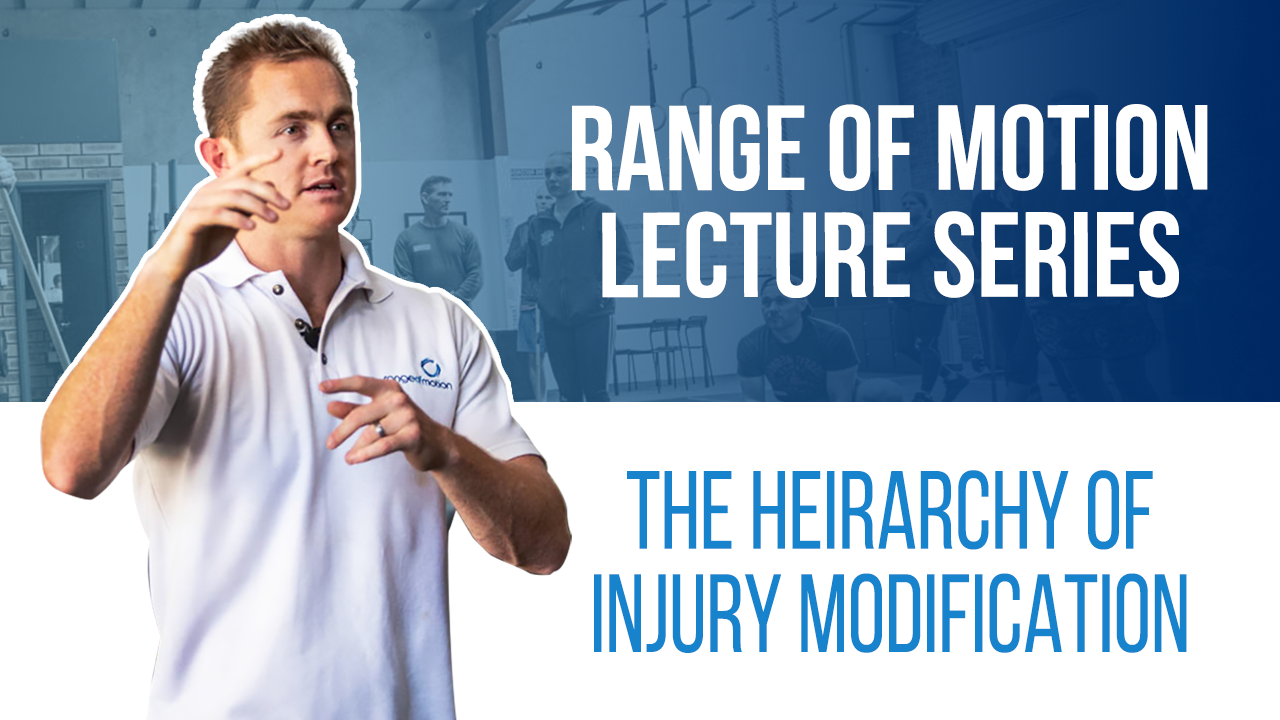Transcribed from video:
– These are ways that we can change an exercise, based on injury. We can change the load, we can reduce the load, we can change the volume, reduce the speed and power. These are ways we can take an exercise that we can’t do because of our injury, and change it. Why is this important? Because your programming has a certain intent. When your coach programmes for you, this seemingly random combination of exercises, at least should have a certain intent. Where you’re creating a blood shunting effect, where you’re alternating conflicting muscle groups, where you’re going from upper body to lower body. There’s an intent there, there’s a programming intent. If you turn a, if you say okay I’ve got a knee injury. If you’ve got a knee injury, what could you substitute that with in training, so if you’re supposed to be running, you’ve got a knee injury, what can you do instead of running?
– Row, ride.
– Row, ride, yeah. Everyone goes I can’t run, therefore I’m going to row. What’s the commonality there? It’s the energy system. Yeah, the same sort of energy system. But, is a row a similar sort of stimulus from a movement point of view as a run is? Doesn’t look anything like it. A row is more similar to a deadlift, a row is more similar to a box jump. It doesn’t look anything like running. So what we need to do is we need to modify the stimulus to modify the exercise the least amount possible from what we’re intending. So if you can’t run, how close to a run can we get? If you can’t deadlift because you’ve got a back injury, how close to a deadlift can we get? Because if we go too far away, we lose the intended stimulus, and you’re not getting the benefit of your programming. The items at the top of the list, this is where we start, we start at number one. This is the least change from the initial stimulus. So let’s talk lower back injuries and deadlifts. Someone’s injured their lower back, they can no longer deadlift, how do we modify it? The item at the top of the list is the least change, the least modified. But because we haven’t changed it much, can you see how it’s also the most likely to aggravate that injury, yeah? Now the item at the bottom of the list, that’s the most changed. It’s the most varied from what our intended stimulus is. So, again, can you see that because of that it’s got the least chance of causing aggravation. But we can’t go straight to this because we want to stay as close as possible but we don’t want to aggravate. So somewhere in the middle here, maybe the top, maybe the bottom, maybe somewhere in the middle, is going to be the point where we’re as close as possible to the intended stimulus, but we’re also not causing aggravation. Everyone with me there? That’s quite an important concept. Can you see how now we start to get a framework for how we can actually modify your training around injury? So let’s run through this. Firstly, in general, and then we’ll have a specific example. So, reducing the load, you go lighter. You lift less weight. Reducing the volume, you do less reps or less sets. Reducing the speed or power, you slow down the movement. Because maybe that then doesn’t aggravate an injury. Reducing the range of motion, you don’t travel as far with that load to reduce the range of motion. Change the contraction type, so your contraction type is like for the bicep curl, concentric, shortening the muscle. Eccentric, lengthening the muscle. Isometric, holding it the same. So maybe you go and say okay well we’re just going to do eccentric, lowering on the pull-ups. We’re just going to do concentric, only lifting on the pull-ups, and then dropping. Or, we’re going to do a static hold at certain ranges. As we go, we’re getting further away from the intended stimulus, but also least likely to aggravate. Changing the movement, but retaining the stimulus in the muscle activation patterns. This is where we still want the same muscles turning on, and this will make more sense when we have some practical examples in a moment. But, we still have the same muscles working, this exercise that we’re changing is quad-dominant, we’re still using the quads, but it’s a completely different exercise. And finally, contralateral, which is opposite limb. The right arm can’t do the work because it’s injured, so we just do it with the left arm. Now the reason that’s so effective, is because of something called cross education. Yeah, who’s familiar with cross education? So, this is basically where if you injure one side of your body, so if I injure my right arm, and if I then do single-arm push-ups with my left, that’s actually going to help to maintain the strength in my right arm. So without even using this arm at all, it’s completely out of action, it’s in a cast. It’s out of action, I can actually maintain strength in this arm by working with this arm. Because, strength isn’t just about the muscle. It’s about our ability to turn the muscles on. And our muscles are turned on as a result of our brain telling our nerves what to do. And we can train our nerve patterns and neural patterns. We can train them by using the left arm, and we can maintain them in the right arm by using the left arm. Okay, so that’s your contralateral, opposite limb. Cross education.





